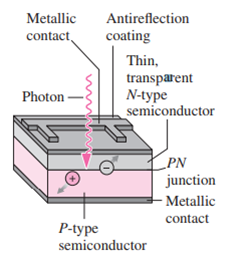Photovoltaic (PV) cells convert sunlight energy directly into electricity, with no moving parts (recall Fig. 37.21). In
Question:
Photovoltaic (PV) cells convert sunlight energy directly into electricity, with no moving parts (recall Fig. 37.21). In a PV cell, photons incident on a semiconductor PN junction promote electrons to the conduction band, producing electron-hole pairs and driving current through an external circuit (Fig. 37.26). Commercially available PV cells are 15?20% efficient, meaning they convert this fraction of incident sunlight into electrical energy; the theoretical maximum efficiency is around 33% for silicon-based PV cells. An important limitation on PV efficiency is the relation between the solar spectrum and PV cells? semiconductor band-gap energy. For silicon, the band gap is 1.14 eV; photons with less energy can?t promote electrons to the conduction zone and are thus unavailable for the PV energy conversion. Conversely, photons with more than the band-gap energy give up their excess energy as heat, also reducing PV efficiency.

One way to improve PV efficiency is to make multilayer cells with several PN junctions using semiconductors with different band gaps. For a multilayer PV cell to be effective,a. the junction with the largest band gap should be closest to the top of the PV cell.b. the junction with the largest band gap should be closest to the bottom of the PV cell.c. the largest band gap should correspond to infrared wavelengths.d. the smallest band gap should correspond to ultraviolet wavelengths.
Step by Step Answer:






